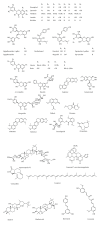Potential antiosteoporotic agents from plants: a comprehensive review
- PMID: 23365596
- PMCID: PMC3551255
- DOI: 10.1155/2012/364604
Potential antiosteoporotic agents from plants: a comprehensive review
Abstract
Osteoporosis is a major health hazard and is a disease of old age; it is a silent epidemic affecting more than 200 million people worldwide in recent years. Based on a large number of chemical and pharmacological research many plants and their compounds have been shown to possess antiosteoporosis activity. This paper reviews the medicinal plants displaying antiosteoporosis properties including their origin, active constituents, and pharmacological data. The plants reported here are the ones which are commonly used in traditional medical systems and have demonstrated clinical effectiveness against osteoporosis. Although many plants have the potential to prevent and treat osteoporosis, so far, only a fraction of these plants have been thoroughly investigated for their physiological and pharmacological properties including their mechanism of action. An attempt should be made to highlight plant species with possible antiosteoporosis properties and they should be investigated further to help with future drug development for treating this disease.
Figures











Similar articles
-
Traditional Chinese medicine formulas for the treatment of osteoporosis: Implication for antiosteoporotic drug discovery.J Ethnopharmacol. 2016 Aug 2;189:61-80. doi: 10.1016/j.jep.2016.05.025. Epub 2016 May 11. J Ethnopharmacol. 2016. PMID: 27180315 Review.
-
Medicinal plants for epileptic seizures: Phytoconstituents, pharmacology and mechanisms revisited.J Ethnopharmacol. 2024 Feb 10;320:117386. doi: 10.1016/j.jep.2023.117386. Epub 2023 Nov 11. J Ethnopharmacol. 2024. PMID: 37956914 Review.
-
Comprehensive Review on the Genus Haloxylon: Pharmacological and Phytochemical Properties.Endocr Metab Immune Disord Drug Targets. 2024;24(10):1146-1160. doi: 10.2174/0118715303270345231121112049. Endocr Metab Immune Disord Drug Targets. 2024. PMID: 38243976 Review.
-
Medicinal plants used against hepatic disorders in Bangladesh: A comprehensive review.J Ethnopharmacol. 2022 Jan 10;282:114588. doi: 10.1016/j.jep.2021.114588. Epub 2021 Sep 1. J Ethnopharmacol. 2022. PMID: 34480997 Review.
-
Traditional uses, phytochemistry, pharmacology and toxicology of the genus Cimicifuga: A review.J Ethnopharmacol. 2017 Sep 14;209:264-282. doi: 10.1016/j.jep.2017.07.040. Epub 2017 Aug 4. J Ethnopharmacol. 2017. PMID: 28826891 Review.
Cited by
-
The Role of Macronutrients, Micronutrients and Flavonoid Polyphenols in the Prevention and Treatment of Osteoporosis.Nutrients. 2022 Jan 25;14(3):523. doi: 10.3390/nu14030523. Nutrients. 2022. PMID: 35276879 Free PMC article. Review.
-
Eucommia, Cuscuta, and Drynaria Extracts Ameliorate Glucocorticoid-Induced Osteoporosis by Inhibiting Osteoclastogenesis Through PI3K/Akt Pathway.Front Pharmacol. 2022 Feb 4;12:772944. doi: 10.3389/fphar.2021.772944. eCollection 2021. Front Pharmacol. 2022. PMID: 35185535 Free PMC article.
-
Plant-Origin Compounds and Materials for Advancing Bone Tissue Engineering and 3D Bioprinting: Traditional Medicine Aspects and Current Perspectives.J Tissue Eng Regen Med. 2025 Jan 7;2025:2812191. doi: 10.1155/term/2812191. eCollection 2025. J Tissue Eng Regen Med. 2025. PMID: 40224956 Free PMC article. Review.
-
Heraclenin promotes the osteogenic differentiation of bone marrow stromal cells by activating the RhoA/ROCK pathway.Histol Histopathol. 2024 Aug;39(8):1065-1077. doi: 10.14670/HH-18-702. Epub 2024 Jan 3. Histol Histopathol. 2024. PMID: 38258549
-
Aesculetin Accelerates Osteoblast Differentiation and Matrix-Vesicle-Mediated Mineralization.Int J Mol Sci. 2021 Nov 17;22(22):12391. doi: 10.3390/ijms222212391. Int J Mol Sci. 2021. PMID: 34830274 Free PMC article.
References
-
- Sambrook P, Cooper C. Osteoporosis. Lancet. 2006;367(9527):2010–2018. - PubMed
-
- Enriori PJ, Enriori CL. The pathogenesis of osteoporosis in older women and men: a review. Journal of Steroid Biochemistry and Molecular Biology. 2002;82(1):1–6. - PubMed
-
- Tremollieres F, Ribot C. Bone mineral density and prediction of non-osteoporotic disease. Maturitas. 2010;65(4):348–351. - PubMed
-
- Gallagher JC. Advances in bone biology and new treatments for bone loss. Maturitas. 2008;60(1):65–69. - PubMed
LinkOut - more resources
Full Text Sources
Other Literature Sources

